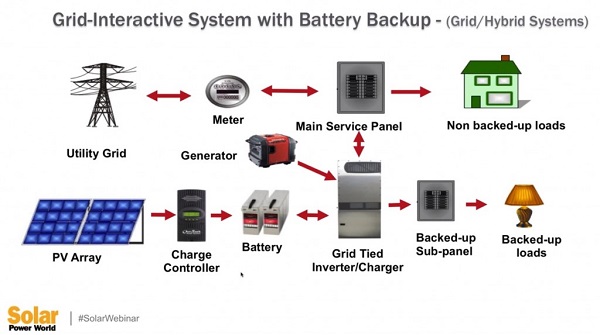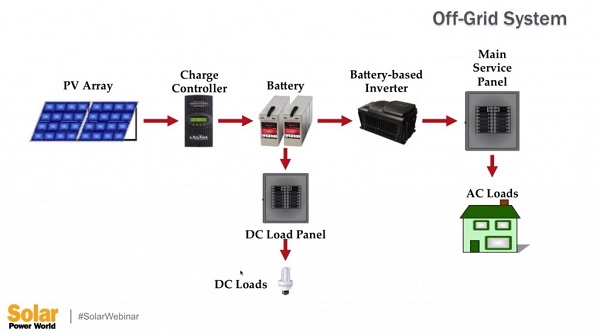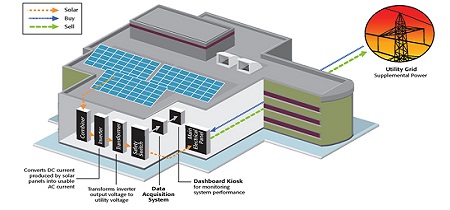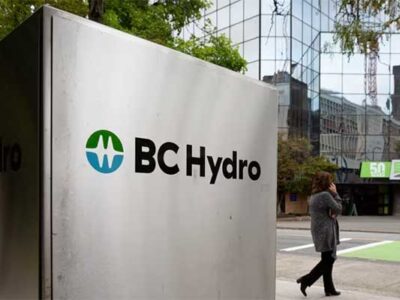In a recent webinar Elise Murphy, a system designer at Washington contractor Fire Mountain Solar, discussed grid-tied vs grid-interactive vs off-grid installations.
Here’s a recap:
There are three main types of solar PV and storage systems: grid-tied, grid/hybrid and off-grid. They all have their advantages and disadvantages and it really comes down to the customer’s current energy supply and what they want to get out of the system.
Grid-tied system
A grid-tied system is a basic solar installation that uses a standard grid-tied inverter and does not have any battery storage. This is perfect for customers who are already on the grid and want to add solar to their house.
These systems can qualify for state and federal incentives which help to pay for the system. Grid-tied systems are simple to design and are very cost effective because they have relatively few components. The main objective of a grid-tied system is to lower your energy bill and benefit from solar incentives.
One disadvantage of this type of system is that when the power goes out, so does your system. This is for safety reasons because linemen working on the power lines need to know there is no source feeding the grid. Grid-tied inverters have to automatically disconnect when they don’t sense the grid.
This means that you cannot provide power during an outage or an emergency and you can’t store energy for later use. You also can’t control when you use the power from your system, such as during peak demand time.
But if a customer has a basic grid-tied system, they are not out of luck if they want to add storage later. The solution is doing an AC-coupled system where the original grid tied inverter is coupled with a battery back-up inverter. This is a great solution for customers who want to install solar now to take advantage of incentives, but aren’t ready to invest in the batteries just yet.
A customer can benefit from net-metering because when the solar is producing more than they are using, they can send power back to the grid. But in times when the loads are higher than what the solar is producing they can buy power from the utility. The customer is not reliant on the solar to power all of his or her load. The main take away is that when the grid goes down, the solar is down as well and there’s no battery back-up in the system.
 This slide shows the components and how a basic grid tie system is put together. There are only a few main components added to the existing utility connection. The inverter is tied directly into the main service panel.
This slide shows the components and how a basic grid tie system is put together. There are only a few main components added to the existing utility connection. The inverter is tied directly into the main service panel.
Grid-tied system with battery back-up
The next type of system is a grid tied system with battery back-up, otherwise known as a grid-hybrid system.
This type of system is ideal for customers who are already on the grid who know that they want to have battery back-up. Good candidates for this type of system are customers who are prone to power outages in their area, or generally just want to be prepared for outages.
With this type of system, you get the best of both worlds because you’re still connected to the grid and can qualify for state and federal incentives, while also lowering your utility bill. At the same time, if there’s a power outage you have back up. Battery based grid-tied systems provide power during an outage and you can store energy for use in an emergency.
You are able to back up essential loads such as lighting and appliances when the power is out. You can also use energy during peak demand times because you can store the energy in your battery bank for later use.
Cons of this system are that they cost more than basic grid-tied systems and are less efficient. There are also more components. The addition of the batteries also requires a charge controller to protect them. There must also be a sub panel that contains the important loads that you want to be backed up.
Not all the loads that the house uses on the grid are backed up with the system. Important loads that are needed when the grid power is down are isolated into a back-up sub panel.
Off-grid system
Off-grid systems are great for customers who can’t easily connect to the grid. This may be because of geographical location or high cost of bringing in the power supply. In most cases, it doesn’t make much sense for a person connected to the grid to completely disconnect and do an off-grid system.
The benefits of an off grid system is that a person can become energy self-sufficient and can power remote places away from the grid. You also have fixed energy costs and won’t be getting a bill from your energy use. Another neat aspect of off grid systems is that they are modular and you can increase the capacity as your energy needs grow. You can start out with a small, budget-conscious system and add on over time.
Because the system is your only source of power, many off-grid systems contain multiple charging sources such as solar, wind and generator. You have to consider weather and year round conditions when designing the system. If your solar panels are covered in snow, you need to have another way to keep your batteries charged up. You also will most likely want to have a back-up generator just in case your renewable sources are not enough at times to keep the batteries charged.
One disadvantage is that off-grid systems may not qualify for some incentive programs. You have to also design your system to cover 100% of your energy loads, and hopefully even a little bit more. Off-grid systems have more components and are more expensive than a standard grid-tied system as well.
 Here is the system diagram of a basic off grid system. You can see all the loads are being supplied by the batteries and there is no grid supply whatsoever. It is also common to have both AC and DC loads in an off grid system because the DC loads may be a little more efficient because they won’t be going through the inverter.
Here is the system diagram of a basic off grid system. You can see all the loads are being supplied by the batteries and there is no grid supply whatsoever. It is also common to have both AC and DC loads in an off grid system because the DC loads may be a little more efficient because they won’t be going through the inverter.
This article has been published here by the PVBUZZ team from a recent webinar by Elise Murphy, a system designer at Washington contractor Fire Mountain Solar. It was edited for publication on Solar Power World Online by Kathie Zipp.
















Comments